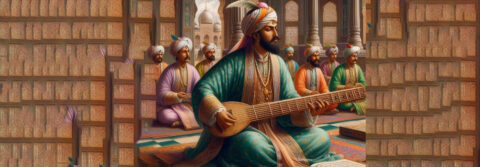Renowned musician, the creator of divine ragas and melodies of Indian Classical music, Tansen. His full name is Ramtanu Pandit. The Mughal emperor Akbar honored him with the title Tansen. The meaning of Tansen is the one who touches the heart with music. He could set fire with his singing if he wanted, and also could make the rain fall from the sky just by singing, just weas the power of his musical notes, his purity of ‘swar’. Tansen was not only a great singer but also a composer and poet. Tansen was the pioneer of modern Dhrupad music, introduced some new forms of ragas, and all those ragas are still associated with his name. For example: Miya Ki Darbari Kanaḍa, Miya Ki Mallar, Miya Ki Todi. These ragas are equally popular among everyone from that era to this day. Despite confusion regarding his birth and death years, it was known from sources that he passed away on May 6, 1589.
Possessing extraordinary abilities, the musical magician Tansen was born in December 1506, in the village of Gwalior in the central province of India. His real name was Ramtanu Pandit. His father Mukund Pandit was a poet and they resided in Varanasi. He did not have any surviving children. It is said that after the blessings from Muhammad Ghaus of Gwalior, Tansen was born. Sheikh Muhammad Gaus was a Sufi Fakir and darvesh in the sixteenth century. He was illustrious among people of all faiths. At the birth of his son, he was overjoyed, believing that the blessings of the saint Gaus were behind this birth. He named his son Ramtanu (Ramtanu Pandit). Ramtanu started learning music from a young age. His guru in this education was the renowned music teacher of Vrindavan, Haridas Swami. His musical talent began to shine at just 10 years old.
It is said that at the age of 10, Ramtanu tried to scare Sangeetacharya Swami Haridas by imitating the call of a tiger from behind a tree. Swamiji was amazed by his talent and asked his father to take him with him to Vrindavan. He studied music there for several years. It is in this Vrindavan that the main foundation of Tansen is laid. He became a famous scholar artist through the smooth practice of various ragas. Even after becoming very famous, he used to come to Vrindavan whenever he got time. After returning to Behat from Vrindavan, Tansen started practicing music in the Shiva temple. It is heard that the walls of the temple used to shake with his music. The locals began to believe that the temple was tilted in one direction because of Tansen’s music. Some more miracles are mentioned about Tansen. For example, moving trees and stones, lighting lamps on your own, and bringing rain when there is no sign of rain. After the death of his parents, Ramtanu went to Gaus and started living with him. During this time, Ramtanu attended the meeting of Raja Man Singh’s widow with the help of Gaus. He converted to Islam and married a Muslim woman, Premkumari, later known as Hosseini. His name is Ali Ahsan. However, it is not known whether Tansen accepted Islam or not. There are both for and against views on this. Tansen is reported to have two wives and five children: 4 sons named Hamir Sen, Surat Sen, Tarang Sen and Bilas Khan and a daughter named Saraswati Devi.
Ata Ali Khan was one of the jewels of Navaratna in the court of Mughal Emperor Akbar. Seven years after Akbar ascended the throne of Delhi, he came to know about Ata Ali Khan in 1562 and placed him in the court of Delhi. At that time he was the court singer of Maharaja Rajaram (Ramchand) of Rewa. Emperor Akbar was so mesmerized by Ata Ali Khan’s singing that he removed the vocal cord from his throat and put it on him and named him Tansen. There were other famous singers and musicians in the court of Akbar during the time of Tansen. Among them were Baba Ram Das, Dariya Khan, Mian Masnad Ali Khan, Surdas, Nawab Khan and Raj Bahadur.
Contemporary musicians of the time resorted to a vicious tactic in envy of such good fortune of Tansen. They asked Deepak to set him on fire. Raga Deepak is such a powerful raga that there was a possibility of burning Tansen’s body in the fire created by the song. Tansen knew it. At first he didn’t agree. He knew that after singing the raga of Deepak, when the fire would burn, it would be necessary to extinguish the raga of Meghmallar. But it is not possible to sing two songs at the same time. The conspirator also knew that Tansen would never perform this raga, so Tansen’s opponent requested Emperor Akbar during the concert to hear Deepak’s raga in Tansen’s voice. In good faith, Emperor Akbar requested Tansen to sing the raga. Tansen sought time from the emperor to perform this dangerous raga. He started training daughter Swaraswati and Guru Kanya in the songs of Megha Malhar to counter the conspirators.
One day after training his daughter Swaraswati and the guru’s daughter, he announced o sing Rag Deepak in the court. No one knew of Tansen’s pre-preparedness. On a particular day, Emperor Akbar himself is sitting in the middle of the music hall. Tansen began to sing Raag Deepak. At one point, all the candles in the hall caught fire. Seeing this, everyone started running away. Tansen’s own body also started to burn. He rushed home. His daughter and daughter-in-law are singing Raag Megha Malhar in the same voice. Rain began to fall from the sky. The rain water extinguished the burning fire of Tansen’s body. He was reportedly bedridden for six months after the incident.
He is not only good in singing but innovated modern musical instruments. It was Tansen’s invention.
This great musician died in Agra on 6 May 1589 at the age of 83. The tomb of Mian Tansen was built in the tomb complex of the great Sufi saint of Gwalior, Sheikh Muhammad Ghaus, at Behat near Gwalior. The two tombs of Gaus and Tansen are side by side. The tomb of Tansen is located on the right side of the tomb of Saint Gaus. The tomb is still intact. Every year in the month of December in the memorial of Tansen a music festival is held at the national level. Artists, musicians, and musicians from all over the world attended.
Info : various sources available in documents, internet archive



